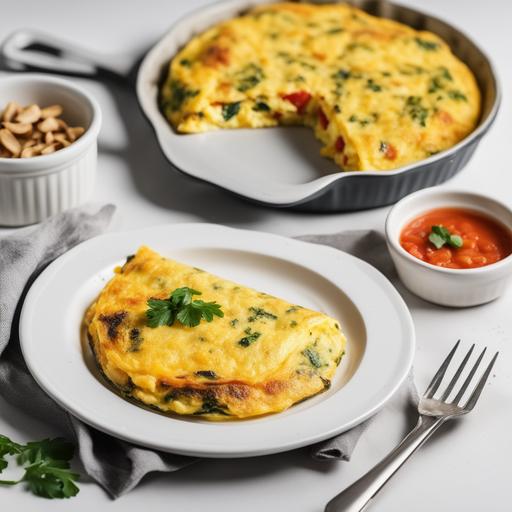
The Ultimate Guide To Making A Perfect Omelette In The Oven
Do you struggle with making the perfect omelette on the stovetop? Have you ever considered making an omelette in the oven? It’s an easy and delicious alternative that is perfect for a crowd or when you don’t have the time or energy to stand at the stove. In this comprehensive guide, we’ll take a deep dive into the world of omelette oven recipes, covering everything you need to know to create the perfect dish.
The Science Behind Cooking Eggs
Before we dive into the details of making an omelette in the oven, let’s discuss the science behind cooking eggs. Eggs are a unique ingredient in that they are incredibly versatile and can be cooked in a variety of ways. When eggs are cooked, the heat causes the protein molecules in the egg to denature and then recombine, setting the egg in its shape. This is why eggs become firm and solid when cooked.
Interestingly, the heat also causes the egg yolk to coagulate. This can be a good thing or a bad thing depending on your preference. If you prefer your eggs runny, it’s essential not to overcook them.
Selecting the Perfect Ingredients
As with any recipe, selecting the right ingredients is key to making a successful omelette in the oven. For the base, you’ll need eggs. Choose fresh, free-range eggs if possible. They will provide the best flavor and texture.
Next, you’ll need to choose your fillings. You can add almost anything to an omelette, from vegetables to meats to cheese. When selecting your fillings, consider the flavors and textures you enjoy. Some popular options include:
-
Chopped vegetables (spinach, mushrooms, bell peppers, onions)
-
Cooked meats (bacon, ham, sausage)
-
Cheese (cheddar, feta, mozzarella)
Cleaning and Preparing the Oven

Before you start making your omelette, you’ll need to clean and prepare your oven. Preheat your oven to 375°F and ensure that your oven rack is in the middle position. You’ll need an oven-safe skillet or baking dish that is large enough to fit your omelette.
Clean your skillet or baking dish thoroughly, removing any dust or debris. You won’t want any leftover food particles spoiling your dish. Finally, apply a thin layer of cooking spray or butter to the skillet or baking dish to prevent sticking.
Tips for Making the Perfect Omelette in the Oven
Making an omelette in the oven is relatively easy, but there are a few tips and tricks that can help you achieve the best results. Here are some tips to follow:
-
Use a whisk to mix your eggs thoroughly. You’ll want your egg mixture to be well combined so that your omelette cooks evenly.
-
Pre-cook any fillings that need to be softened. If you’re using vegetables or meats that require cooking, sauté them in a skillet before adding them to your egg mixture.
-
Sprinkle your fillings on top of the egg mixture instead of mixing them. This will ensure even distribution of the fillings.
-
Don’t overfill your skillet or baking dish. You’ll want to leave some room for the egg mixture to expand. If you overfill, your omelette may not cook correctly.
-
Check your omelette after 15 minutes of cooking. Every oven is different, and your omelette may require more or less time depending on your oven’s performance.
Variations on the Omelette Oven Recipe
One of the great things about making an omelette in the oven is its versatility. You can customize it to suit your preferences and dietary restrictions. Here are some variations to try:
-
Vegetarian omelette: skip the meats and add extra vegetables such as sun-dried tomatoes or artichokes.
-
Low-carb omelette: swap the cheese for a plant-based option such as nutritional yeast, and avoid using potatoes or bread in the filling.
-
Gluten-free omelette: avoid using bread or other gluten-containing ingredients.
-
Dairy-free omelette: substitute cheese with a dairy-free option such as nut-based cheese.
Doneness Checks

It’s essential to cook your omelette to the desired doneness. Here’s how you can check if your omelette is cooked thoroughly:
-
Insert a toothpick into the center of the omelette. If it comes out clean, your omelette is done.
-
Gently press on the center of the omelette. If it feels firm, it’s fully cooked. If it still feels spongy, it needs more time in the oven.
Recipe: Omelette Oven Recipe
Ready to get started? Here’s a simple recipe for making an omelette in the oven:
Ingredients:
-
6 large eggs
-
1/4 cup heavy cream
-
Salt and pepper, to taste
-
1/2 cup cooked, chopped vegetables (spinach, mushrooms, bell peppers, onions)
-
1/4 cup cooked, crumbled bacon
-
1/2 cup shredded cheddar cheese
Instructions:
-
Preheat your oven to 375°F.
-
In a large bowl, whisk the eggs, cream, salt, and pepper together until well combined.
-
Add your chopped vegetables, bacon, and shredded cheese to the egg mixture.
-
Pour the egg mixture into an oven-safe skillet or baking dish that has been coated in cooking spray or butter.
-
Bake the omelette for 20-25 minutes or until the center is firm and fully cooked.
-
Remove from the oven and let cool for a few minutes before serving.
Overcooked vs. Undercooked
While it’s essential to cook your omelette fully, it’s equally important not to overcook it. Overcooked eggs can become dry and rubbery, making them unappetizing. Here are some signs that your omelette may be overcooked:
-
The egg appears overly dry and browned.
-
The egg has a tough texture and is difficult to chew.
Conversely, undercooked eggs can be unappetizing and even dangerous to consume if raw. Here are some signs that your omelette may be undercooked:
-
The egg is still runny or wet in the center.
-
The egg appears pale and uncooked.
Conclusion
Making an omelette in the oven is an easy and delicious alternative to a stovetop omelette. And with this comprehensive guide, you now have all the tools you need to create the perfect dish. Whether you opt for a classic filling or a unique variation, an omelette oven recipe is sure to be a crowd-pleaser. So invite some friends over, preheat your oven, and let’s get cooking!
Sources
FAQS On Omelette Oven Recipe
What Is An Omelette Oven Recipe?
An omelette oven recipe is a cooking method that involves baking or roasting an omelette mixture in the oven instead of the traditional stovetop method. This technique results in a fluffy and evenly cooked omelette with minimal effort.
How Long Does It Take To Cook An Omelette In The Oven?
The cooking time may vary depending on the recipe and the size of the omelette. Typically, it takes around 20-25 minutes to cook an omelette in the oven. However, it is important to always follow the specific instructions mentioned in the recipe you are using to achieve the desired texture and doneness.
Can I Use Any Kind Of Oven-safe Pan For An Omelette Oven Recipe?
Yes, you can use any oven-safe pan for cooking omelettes in the oven. Popular options include cast iron skillets, non-stick baking pans, and ceramic dishes. Just make sure that the pan you choose can withstand high temperatures and does not have any plastic or rubber parts that could melt or release harmful chemicals.
What Ingredients Can I Add To An Omelette Oven Recipe?
The ingredients you can add to an omelette oven recipe are nearly limitless. You can use a variety of vegetables such as bell peppers, mushrooms, onions, spinach, or tomatoes to add flavor and nutrients. Cheese, herbs, and cooked meats like bacon or sausage can also be great additions. Be creative and experiment with different combinations to suit your taste.
Can I Prepare The Omelette Mixture Ahead Of Time And Refrigerate It Overnight?
Yes, you can prepare the omelette mixture ahead of time and refrigerate it overnight. This can be convenient when you want to save time in the morning or have a ready-to-bake omelette for a brunch gathering. However, it is important to note that certain ingredients, such as vegetables, may release excess moisture when stored in the mixture overnight. To minimize this, you can drain or sauté the vegetables before adding them to the mixture.


